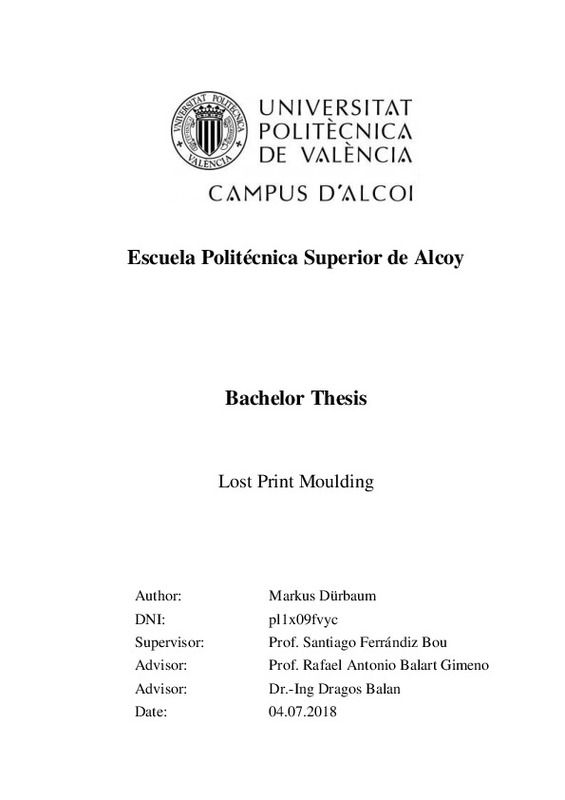JavaScript is disabled for your browser. Some features of this site may not work without it.
Buscar en RiuNet
Listar
Mi cuenta
Estadísticas
Ayuda RiuNet
Admin. UPV
Lost print moulding
Mostrar el registro sencillo del ítem
Ficheros en el ítem
| dc.contributor.advisor | Balart Gimeno, Rafael Antonio
|
es_ES |
| dc.contributor.advisor | Ferrándiz Bou, Santiago
|
es_ES |
| dc.contributor.advisor | Balan, Dragos
|
es_ES |
| dc.contributor.author | Dürbaum, Markus
|
es_ES |
| dc.date.accessioned | 2018-11-16T17:38:01Z | |
| dc.date.available | 2018-11-16T17:38:01Z | |
| dc.date.created | 2018-07-24 | |
| dc.date.issued | 2018-11-16 | es_ES |
| dc.identifier.uri | http://hdl.handle.net/10251/112643 | |
| dc.description.abstract | [ES] Esta tesis de grado se trata de la verificación de viabilidad y la optimización de una nueva técnica de prototipado rápido "Fundición de impresión perdida" para fundir metales ligeros en formas más complicadas. En parte es como el molde de cera perdida existente, pero en lugar de usar cera o plásticos que deben quemarse a altas temperaturas, utiliza un material soluble para imprimir en 3D lo positivo. La mayor ventaja es que no se necesita horno o chimenea para quitar el núcleo. El proceso de quemar el material representa, cuando se hace con una chimenea simple y barata, la mayor tasa de falla al introducir grietas térmicas debido a un calentamiento no uniforme. Para un calentamiento uniforme, sería necesario un horno relativamente caro para altas temperaturas. Otra ventaja especialmente se vuelve relevante con alta complejidad. Mientras que durante el proceso de quemado el material fluye por gravedad o se quema, es posible que queden restos en el molde, afectando la calidad y las dimensiones de la pieza fundida. La fundición de impresión perdida no necesita un horno especial ni arriesgarse a sufrir grietas térmicas durante la extracción. Solo necesita enjuagarse con el líquido de solución. El público objetivo potencial es el taller de bricolaje y las pequeñas empresas con impresora 3D FDM, porque excepto el inevitable derretimiento de los metales ligeros, solo requiere poco dinero y relativamente mucho tiempo de trabajo. Para las medianas y grandes empresas, el proceso de producción de formas complejas en metal está dominado por metal-3D-printing y fundición a la cera perdida con material especializado, ya que de hecho requieren máquinas muy costosas, pero requieren menos mecanizado y tiempo de trabajo | es_ES |
| dc.description.abstract | [EN] This bachelor thesis is about the feasibility check and optimization of a new rapid prototyping technique Lost-Print Casting to cast light metals in more complicated forms. Partly it is like the existing lost-wax casting, but instead of using wax or plastics that must be burned out at high temperatures, it uses a soluble material to 3D-print the positive. The biggest advantage is that no oven or fireplace is necessary for the removing of the core. The process of burning out the material represents, when done with a simple and cheap fireplace, the highest rate of failure by introducing thermal cracks because of non-uniformly heating. For a uniformly heating, a relatively expensive oven for high temperatures would be necessary. Another advantage especially becomes relevant with high complexity. While during the burn out process the material either flows out by gravity or burns up, it is possible that leftovers remain in the mould, affecting the quality and dimensions of the casted part. The lost-print-casting doesn t need a special oven nor risking thermal cracks during the removal. It only needs to be flushed out with the solver liquid. The potential target audience is the DIY-workshop and small companies with FDM 3D-printer, because except the unavoidable melting of the light metals, it only requires few money and relatively much work time. For middle and big companies, the process of producing complex shapes out of metal is dominated by metal-3D-printing and lost-wax casting with specialised material, because they indeed require very expensive machines, but are requiring less machining and working time | es_ES |
| dc.format.extent | 34 | es_ES |
| dc.language | Inglés | es_ES |
| dc.publisher | Universitat Politècnica de València | es_ES |
| dc.rights | Reconocimiento - No comercial (by-nc) | es_ES |
| dc.subject | PVA | es_ES |
| dc.subject | 3d print | es_ES |
| dc.subject | cera perdida | es_ES |
| dc.subject | fundicion | es_ES |
| dc.subject | Lost Casting | es_ES |
| dc.subject.classification | INGENIERIA DE LOS PROCESOS DE FABRICACION | es_ES |
| dc.subject.classification | CIENCIA DE LOS MATERIALES E INGENIERIA METALURGICA | es_ES |
| dc.subject.other | Grado en Ingeniería Mecánica-Grau en Enginyeria Mecànica | es_ES |
| dc.title | Lost print moulding | es_ES |
| dc.type | Proyecto/Trabajo fin de carrera/grado | es_ES |
| dc.rights.accessRights | Abierto | es_ES |
| dc.contributor.affiliation | Universitat Politècnica de València. Escuela Politécnica Superior de Alcoy - Escola Politècnica Superior d'Alcoi | es_ES |
| dc.contributor.affiliation | Universitat Politècnica de València. Departamento de Ingeniería Mecánica y de Materiales - Departament d'Enginyeria Mecànica i de Materials | es_ES |
| dc.contributor.affiliation | Universitat Politècnica de València. Instituto de Tecnología de Materiales - Institut de Tecnologia de Materials | es_ES |
| dc.description.bibliographicCitation | Dürbaum, M. (2018). Lost print moulding. http://hdl.handle.net/10251/112643 | es_ES |
| dc.description.accrualMethod | TFGM | es_ES |
| dc.relation.pasarela | TFGM\87354 | es_ES |
Este ítem aparece en la(s) siguiente(s) colección(ones)
-
EPSA - Trabajos académicos [5826]
Escuela Politécnica Superior de Alcoy






